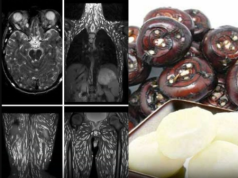When a loved one is nearing the end of life, the body begins a quiet, natural process of shutting down.
Among the many changes — slowing breath, cool extremities, decreased consciousness — one of the most misunderstood and emotionally difficult to witness is the “death rattle.”
Often described as a gurgling, rattling, or bubbling sound with each breath, this noise can be deeply unsettling for family members.
But medical experts and hospice professionals want you to know:
👉 The death rattle is not painful.
👉 It is not a sign of suffering.
👉 It is a normal, natural part of the dying process.
Understanding what it is — and what it means — can bring comfort during one of life’s most tender moments.
What Is the ‘Death Rattle’?
The “death rattle” — medically known as terminal respiratory secretions — is a sound caused by the accumulation of saliva and mucus in the back of the throat when a person can no longer swallow or clear their airway.
As the body prepares to stop functioning, the muscles responsible for swallowing weaken or stop working altogether.
This allows fluids to pool in the throat, and as air passes over them with each breath, it creates the characteristic wet, crackling sound.
💬 “It’s just a small bit of saliva in the back of the throat — it sounds bad, but the person isn’t aware of it,” says Julie, a seasoned hospice nurse with over two decades of end-of-life care experience.
What Does the Death Rattle Sound Like?
The sound varies from person to person, but it’s often described as:
- A low gurgle or bubbling noise
- A wet snore or crackling with each breath
- Sometimes a soft groaning or rattling deep in the chest
It may come and go, and it often worsens when lying flat.
Despite its alarming sound, the person is typically unconscious or semi-conscious and feels no discomfort.
🌿 Important: The death rattle is not the same as choking — the individual is not struggling to breathe.
Why It Happens: The Body’s Final Transition
In the final 24–48 hours of life, the body naturally begins to:
- Conserve energy
- Reduce circulation to extremities
- Slow breathing and heart rate
- Lose the ability to swallow
This is part of the body’s way of turning inward, focusing on internal comfort rather than external function.
The death rattle is simply a byproduct of this process — not a medical emergency.
How Long After the Death Rattle Does Passing Occur?
Research shows that once the death rattle begins, most people pass away within 25 hours on average.
However, this can vary:
- Some may live for just a few hours
- Others may linger for up to 3 days
Interestingly, studies suggest the process may last longer in hospice or home settings, where comfort care is prioritized over aggressive interventions.
Common Misconceptions About the Death Rattle
❌ “They’re drowning.”
✅ No — they are not aware of the fluid, and they are not suffocating.
❌ “They’re in pain.”
✅ No — the brain is no longer registering the sensation. They are typically peaceful.
❌ “We need to give them water.”
✅ No — giving fluids at this stage can increase secretions and worsen the rattle.
How to Comfort Your Loved One (And Yourself)
While the death rattle cannot always be prevented, there are gentle, compassionate ways to reduce its intensity and support your loved one’s dignity.
✅ 1. Reposition the Body
- Gently turn the person onto their side or slightly elevated
- This helps secretions drain naturally and reduces the sound
✅ 2. Elevate the Head
- Use pillows to raise the head slightly — never force or over-raise
- Promotes easier drainage and comfort
✅ 3. Keep the Mouth Moist
- Use damp swabs or a moistened cloth to gently wipe the lips and mouth
- Prevents dryness without adding fluids
✅ 4. Limit Oral Fluids
- At this stage, the body can no longer process fluids
- Continuing to offer water or ice chips can increase secretions
✅ 5. Medications (When Prescribed)
- Doctors may prescribe anticholinergic medications (like scopolamine or glycopyrrolate) to reduce saliva production
- These are often given via patch or injection and are very effective
✅ 6. Avoid Suctioning (Unless Medically Necessary)
- Oral suctioning is not recommended in most home or hospice settings
- It can be uncomfortable and distressing — and often doesn’t help much
Support for Family and Caregivers
Hearing the death rattle can be emotionally overwhelming.
You might feel helpless, anxious, or afraid your loved one is suffering.
But here’s what you need to know:
❤️ Your presence is the greatest comfort.
❤️ They can still hear you — speak gently, hold their hand, play soft music.
❤️ You are not alone — hospice teams are trained to guide you through this.
Talking to a nurse or counselor can help ease your fears and provide reassurance.
Final Thoughts: A Natural Part of Letting Go
The death rattle is not a sign of fear or pain —
It is a sign that the body is completing its final journey with dignity.
It is not something to fear.
It is something to witness with love, understanding, and peace.
As Julie reminds us:
“It’s all very normal. It’s part of the natural process of dying. And it’s okay.”
So if you’re by the bedside of someone you love, take their hand.
Whisper your goodbyes.
And know that in that quiet room, something sacred is happening.
The body may rattle — but the soul is already at peace.










